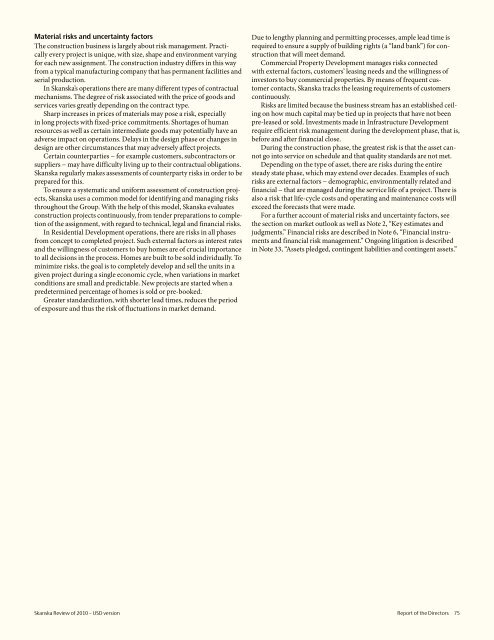Review of 2010 â USD version - Skanska
Review of 2010 â USD version - Skanska
Review of 2010 â USD version - Skanska
Create successful ePaper yourself
Turn your PDF publications into a flip-book with our unique Google optimized e-Paper software.
Material risks and uncertainty factors<br />
The construction business is largely about risk management. Practically<br />
every project is unique, with size, shape and environment varying<br />
for each new assignment. The construction industry differs in this way<br />
from a typical manufacturing company that has permanent facilities and<br />
serial production.<br />
In <strong>Skanska</strong>’s operations there are many different types <strong>of</strong> contractual<br />
mechanisms. The degree <strong>of</strong> risk associated with the price <strong>of</strong> goods and<br />
services varies greatly depending on the contract type.<br />
Sharp increases in prices <strong>of</strong> materials may pose a risk, especially<br />
in long projects with fixed-price commitments. Shortages <strong>of</strong> human<br />
resources as well as certain intermediate goods may potentially have an<br />
adverse impact on operations. Delays in the design phase or changes in<br />
design are other circumstances that may adversely affect projects.<br />
Certain counterparties − for example customers, subcontractors or<br />
suppliers − may have difficulty living up to their contractual obligations.<br />
<strong>Skanska</strong> regularly makes assessments <strong>of</strong> counterparty risks in order to be<br />
prepared for this.<br />
To ensure a systematic and uniform assessment <strong>of</strong> construction projects,<br />
<strong>Skanska</strong> uses a common model for identifying and managing risks<br />
throughout the Group. With the help <strong>of</strong> this model, <strong>Skanska</strong> evaluates<br />
construction projects continuously, from tender preparations to completion<br />
<strong>of</strong> the assignment, with regard to technical, legal and financial risks.<br />
In Residential Development operations, there are risks in all phases<br />
from concept to completed project. Such external factors as interest rates<br />
and the willingness <strong>of</strong> customers to buy homes are <strong>of</strong> crucial importance<br />
to all decisions in the process. Homes are built to be sold individually. To<br />
minimize risks, the goal is to completely develop and sell the units in a<br />
given project during a single economic cycle, when variations in market<br />
conditions are small and predictable. New projects are started when a<br />
predetermined percentage <strong>of</strong> homes is sold or pre-booked.<br />
Greater standardization, with shorter lead times, reduces the period<br />
<strong>of</strong> exposure and thus the risk <strong>of</strong> fluctuations in market demand.<br />
Due to lengthy planning and permitting processes, ample lead time is<br />
required to ensure a supply <strong>of</strong> building rights (a “land bank”) for construction<br />
that will meet demand.<br />
Commercial Property Development manages risks connected<br />
with external factors, customers’ leasing needs and the willingness <strong>of</strong><br />
investors to buy commercial properties. By means <strong>of</strong> frequent customer<br />
contacts, <strong>Skanska</strong> tracks the leasing requirements <strong>of</strong> customers<br />
continuously.<br />
Risks are limited because the business stream has an established ceiling<br />
on how much capital may be tied up in projects that have not been<br />
pre-leased or sold. Investments made in Infrastructure Development<br />
require efficient risk management during the development phase, that is,<br />
before and after financial close.<br />
During the construction phase, the greatest risk is that the asset cannot<br />
go into service on schedule and that quality standards are not met.<br />
Depending on the type <strong>of</strong> asset, there are risks during the entire<br />
steady state phase, which may extend over decades. Examples <strong>of</strong> such<br />
risks are external factors − demographic, environmentally related and<br />
financial − that are managed during the service life <strong>of</strong> a project. There is<br />
also a risk that life-cycle costs and operating and maintenance costs will<br />
exceed the forecasts that were made.<br />
For a further account <strong>of</strong> material risks and uncertainty factors, see<br />
the section on market outlook as well as Note 2, “Key estimates and<br />
judgments.” Financial risks are described in Note 6, “Financial instruments<br />
and financial risk management.” Ongoing litigation is described<br />
in Note 33, “Assets pledged, contingent liabilities and contingent assets.”<br />
<strong>Skanska</strong> <strong>Review</strong> <strong>of</strong> <strong>2010</strong> – <strong>USD</strong> <strong>version</strong> Report <strong>of</strong> the Directors 75

















